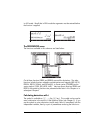
Page 13-11
Θ Level 3: the function f(VX)
Θ Two lists, the first one indicates the variation of the function (i.e., where
it increases or decreases) in terms of the independent variable VX, the
second one indicates the variation of the function in terms of the
dependent variable.
Θ A graphic object showing how the variation table was computed.
Example: Analyze the function Y = X
3
-4X
2
-11X+30, using the function TABVAR.
Use the following keystrokes, in RPN mode:
'X^3-4*X^2-11*X+30' `‚N ~t(select TABVAR) @@OK@@
This is what the calculator shows in stack level 1:
This is a graphic object. To be able to the result in its entirety, press ˜. The
variation table of the function is shown as follows:
Press $ to recover normal calculator display. Press ƒ to drop this last
result from the stack.
Two lists, corresponding to the top and bottom rows of the graphics matrix
shown earlier, now occupy level 1. These lists may be useful for programming
purposes. Press ƒ to drop this last result from the stack.


















